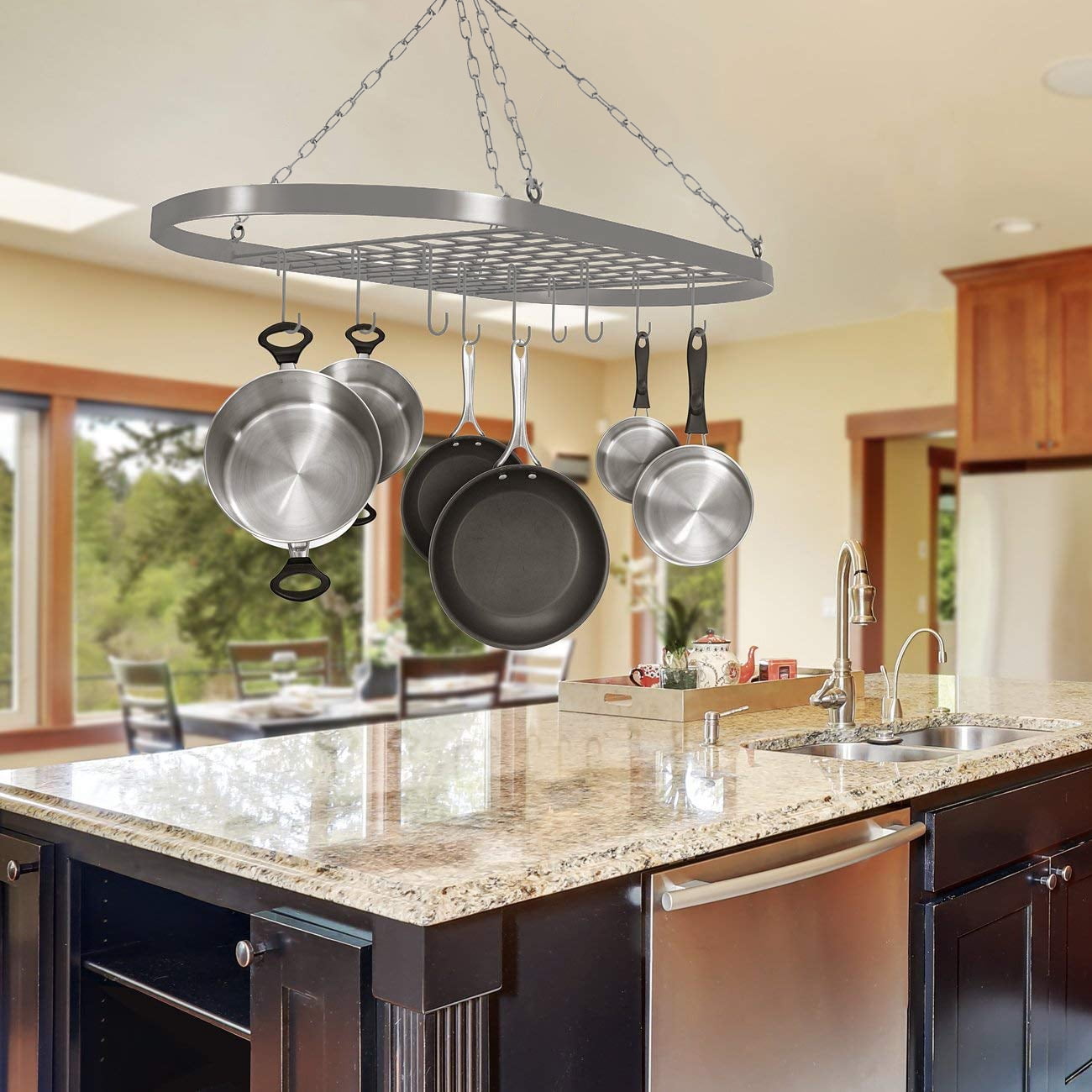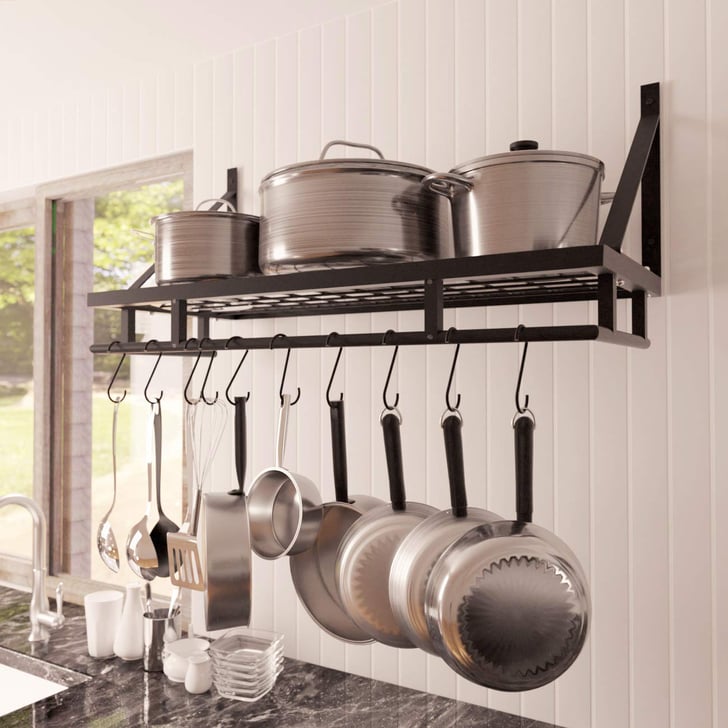Types of Kitchen Cabinets for Pots and Pans: Kitchen Cabinet For Pots And Pans

Organizing pots and pans can be a challenge, especially if you have a limited amount of kitchen space. Thankfully, there are various types of kitchen cabinets specifically designed for storing these essential kitchen items. These cabinets offer a blend of functionality and aesthetics, ensuring that your pots and pans are not only neatly stored but also easily accessible when needed.
Pull-Out Drawers
Pull-out drawers are a popular choice for storing pots and pans. These drawers are designed to slide out smoothly, allowing you to access your items without having to rummage through deep cabinets. They are often equipped with dividers or adjustable shelves, which help to keep your pots and pans organized and prevent them from clanging together.
- Full-Extension Drawers: These drawers extend completely, providing easy access to the entire contents. They are ideal for storing larger pots and pans, as they allow you to see everything at a glance.
- Soft-Close Drawers: These drawers feature a mechanism that allows them to close slowly and quietly, preventing them from slamming shut. This feature is particularly useful in kitchens where noise is a concern.
Here’s a table summarizing the advantages and disadvantages of pull-out drawers:
| Cabinet Type | Description | Advantages | Disadvantages |
|---|---|---|---|
| Pull-Out Drawers | Drawers that slide out for easy access to pots and pans. | Easy access, organized storage, prevent clanging, various sizes available. | Can be expensive, require more space than other options. |
Pot Racks
Pot racks are a classic solution for storing pots and pans. They typically consist of a metal frame with hooks or bars that hang from the ceiling or a wall. Pot racks are a great way to display your cookware and can add a touch of rustic charm to your kitchen.
- Ceiling-Mounted Pot Racks: These racks are suspended from the ceiling, maximizing floor space and providing a visually appealing storage solution.
- Wall-Mounted Pot Racks: These racks are mounted directly to the wall, offering a more compact storage option.
Here’s a table summarizing the advantages and disadvantages of pot racks:
| Cabinet Type | Description | Advantages | Disadvantages |
|---|---|---|---|
| Pot Racks | Metal frames with hooks or bars for hanging pots and pans. | Aesthetically pleasing, maximizes space, easy access. | Can be bulky, not suitable for all kitchens, may require professional installation. |
Vertical Organizers
Vertical organizers are a space-saving solution for storing pots and pans. These organizers typically consist of a narrow cabinet with shelves or dividers that are designed to hold pots and pans vertically. They are a great option for small kitchens or for maximizing storage space in a corner.
- Revolving Organizers: These organizers have a rotating mechanism that allows you to easily access all of your pots and pans. They are ideal for storing a large collection of cookware.
- Pull-Out Organizers: These organizers slide out like drawers, providing easy access to your pots and pans. They are often equipped with dividers or adjustable shelves to keep your cookware organized.
Here’s a table summarizing the advantages and disadvantages of vertical organizers:
| Cabinet Type | Description | Advantages | Disadvantages |
|---|---|---|---|
| Vertical Organizers | Narrow cabinets with shelves or dividers for storing pots and pans vertically. | Space-saving, easy access, various sizes available. | Can be expensive, not suitable for storing large pots and pans. |
Organization and Storage Solutions

A well-organized kitchen cabinet can transform your cooking experience, making it easier to find what you need and streamline your workflow. Organizing pots and pans effectively involves a combination of techniques that optimize space and ensure efficient access.
Storing Pots and Pans Based on Size
Organizing pots and pans by size is a fundamental principle for maximizing space and ensuring easy retrieval. This method allows you to stack pots and pans within the cabinet without creating a chaotic jumble.
- Larger Pots and Pans: Store these at the bottom of the cabinet, as they are less frequently used and their weight will not impact lighter items above.
- Medium-Sized Pots and Pans: Place these in the middle section of the cabinet, ensuring they are easily accessible.
- Smaller Pots and Pans: Keep these on the top shelves, as they are likely used more frequently.
Storing Pots and Pans Based on Material
Grouping pots and pans by material can simplify cleaning and maintenance.
- Cast Iron: Cast iron cookware requires special care, so it is beneficial to keep these pieces together for easy access to cleaning supplies and storage solutions.
- Stainless Steel: Stainless steel cookware is generally easier to clean and maintain, so grouping these pieces together can simplify your routine.
- Non-Stick: Non-stick cookware is often more delicate and requires specific cleaning methods. Storing these pieces together ensures they are handled with care and maintained properly.
Storing Pots and Pans Based on Frequency of Use
Organizing pots and pans by frequency of use can streamline your cooking process, making it easier to find the right tools for the job.
- Frequently Used Items: Store these on the most accessible shelves, making them easily reachable.
- Less Frequently Used Items: Place these on the lower shelves, as they are not as essential for daily cooking.
Visual Representation of a Well-Organized Pot and Pan Storage System, Kitchen cabinet for pots and pans
Imagine a kitchen cabinet with three shelves. The bottom shelf is dedicated to larger pots and pans, such as stockpots and Dutch ovens. The middle shelf houses medium-sized pots and pans, like saucepans and skillets. The top shelf is reserved for smaller pots and pans, such as saucepans and frying pans. Within each shelf, pots and pans are further organized by material, with cast iron pieces stored together, stainless steel pieces in a separate area, and non-stick cookware in a designated space. Frequently used pots and pans are placed at the front of each shelf, while less frequently used items are stored towards the back.
A well-organized pot and pan storage system is characterized by easy access, clear visibility, and efficient utilization of space.
Materials and Features

Choosing the right materials and features for your pot and pan cabinet is crucial for ensuring both functionality and longevity. The materials you choose will impact the cabinet’s durability, aesthetics, and overall performance, while the features will determine how easy it is to organize and access your cookware.
Materials Used for Pot and Pan Cabinets
The material used for a pot and pan cabinet plays a significant role in its overall performance and lifespan. Here’s a breakdown of common materials and their respective benefits and drawbacks:
- Wood: Known for its natural beauty and durability, wood is a popular choice for pot and pan cabinets. It’s a sturdy material that can withstand heavy loads, and its warm tones can add a touch of elegance to your kitchen.
- Benefits:
- Durable and strong
- Aesthetically pleasing
- Can be stained or painted to match your kitchen decor
- Offers excellent sound dampening, reducing noise when closing doors or drawers
- Drawbacks:
- Susceptible to moisture damage, requiring regular maintenance
- More expensive than other materials
- May require special care to prevent scratches and dents
- Benefits:
- Metal: Metal cabinets are often favored for their durability and resistance to moisture and heat. They are also relatively inexpensive, making them a practical choice for many homeowners.
- Benefits:
- Highly durable and resistant to moisture and heat
- Easy to clean and maintain
- Typically more affordable than wood cabinets
- Drawbacks:
- Can be prone to dents and scratches
- May not offer the same level of sound dampening as wood
- Can be less aesthetically pleasing than wood
- Benefits:
- Plastic: While less common than wood or metal, plastic cabinets offer a budget-friendly option that is lightweight and easy to clean.
- Benefits:
- Affordable and lightweight
- Easy to clean and maintain
- Resistant to moisture and mildew
- Drawbacks:
- Not as durable as wood or metal
- May not be as aesthetically pleasing
- Can be prone to scratches and dents
- Benefits:
Features that Enhance Functionality
Beyond the material, several features can significantly enhance the functionality of your pot and pan cabinet.
- Adjustable Shelves: These allow you to customize the space within your cabinet to accommodate various pot and pan sizes.
- Benefits:
- Maximize storage space
- Accommodate different sized cookware
- Make it easier to find what you need
- Benefits:
- Soft-Close Drawers: These drawers close smoothly and quietly, preventing slamming and potential damage to your cookware.
- Benefits:
- Reduce noise and wear and tear on drawers
- Protect your cookware from damage
- Enhance the overall user experience
- Benefits:
- Built-in Dividers: These can help to separate and organize your pots and pans, making it easier to find what you need and preventing them from getting tangled or damaged.
- Benefits:
- Maximize storage space
- Prevent cookware from getting tangled
- Make it easier to find what you need
- Benefits:
Kitchen cabinet for pots and pans – Keeping your kitchen cabinets organized is a must, especially when it comes to storing pots and pans. These heavy items can leave behind a greasy residue on the cabinet tops, making them look dull and unappealing. To keep your kitchen sparkling, it’s important to regularly clean these greasy surfaces, and we have a great resource for you on cleaning greasy cabinet tops.
Once you’ve tackled the grime, you can enjoy a clean and organized kitchen where your pots and pans are easily accessible.
Organizing your kitchen can be a breeze with a dedicated cabinet for pots and pans. If you’re looking for a rustic and charming touch, consider using knotty pine cabinet doors for your pots and pan cabinet. The natural grain patterns and knots will add warmth and character to your kitchen while providing a practical storage solution for your cooking essentials.
